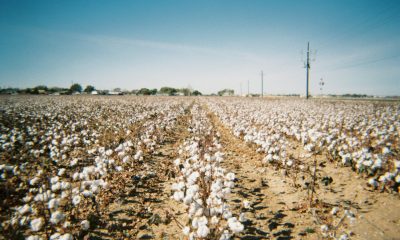Featured
Why FCOJ Futures Had a Good Week
FCOJ closed higher again last week as Florida weather remains non-threatening and the cold weather has passed in Brazil. Reports of freezing temperatures in Sao Paulo Brazil that could affect the production of Oranges in the state continue to support futures prices. Freezing temperatures have been reported in the state in the last couple of weeks. Weather conditions in Florida are rated mostly good for the crops.

Wheat: Winter Wheat markets closed higher for the week as the weather market continued and this time featured dry weather in southern Russia as well as the northern US Great Plains and Canadian Prairies. Trends in Winter Wheat markets are still up. Crop size estimates in Russia have been reduced and are now well below the latest USDA estimates. It is still forecast to be hot and dry in the Great Plains and Canadian Prairies for the next couple of weeks and Minneapolis remains in a trading range. The market is hearing about too wet weather in China and Europe and dry conditions in southern Russia and Kazakhstan. Europe is expecting top yields as are parts of eastern Europe and northern Russia. It has been very cold in South America and the winter crops are in trouble in Brazil and Paraguay. US White Winter Wheat production is also being hurt by hot and dry weather but a few showers are possible in the region this week. World prices might have bottomed and should start to move higher, supporting Wheat futures markets in the US.
Weekly Chicago Soft Red Winter Wheat Futures

Weekly Chicago Hard Red Winter Wheat Futures

Weekly Minneapolis Hard Red Spring Wheat Futures

Corn: Corn was mixed on Friday and has spent the last two weeks trading inside a narrow trading range. The market is looking ahead to the USDA reports on Thursday that are expected to show yield potential for Corn between 176 and 182 bushels per acre. Demand has improved in the past week, and the weather remains a feature of the trade. Some forecasts call for improved weather, especially in the eastern belt. The growing conditions in the US are highly variable and not likely to produce trend line or record yields. It is still too dry in many areas of the west and drier weather is expected in the east. It should stay hot in the west and cool in the east. Ideas are that Brazil Corn production will be less than 90 million tons so reduced production estimates are expected in coming reports. Oats were higher with the other ag markets and the uncertain weather in the northern Great Plains and Canadian Prairies. Canadian Oats areas and those in the northern Great Plains remain too hot and dry. Some rain is now in the forecast but is too little and too late to materially help crops. Longer range forecasts released by NWS call for warmer and drier weather for many important US growing areas this Summer.
Weekly Corn Futures

Weekly Oats Futures

Soybeans and Soybean Meal: Soybeans were lower for the week and Soybean Meal was a little higher on more forecasts for good production and improved weather along with worries about weaker than expected demand. Trade ideas are that the US national yield can be 50 bushels per acre at minimum and production can be at least 4.2 billion bushels. Demand has started to improve as there were announcements of sales of soybeans last Thursday and Friday. Soybean Oil was lower for the week-on-demand concerns as there is still little news about new biofuels mandates. Chart trends remain sideways or down in all three markets. US weather is still a feature in the market as it remains hot in the west and is dry in just about all areas now. Eastern Midwest areas should be cooler. Soybeans conditions in the central production area started the year too wet and have suffered. Minnesota and northern Iowa and the Dakotas have been very hot and dry but western Iowa got very beneficial rain over the weekend. Forecasts call for warmer weather this week in the western Midwest and northern Great Plains but cooler than normal in the eastern Midwest, and it should generally be dry. The longer-range forecasts from NWS call for warmer and drier than normal conditions for most Soybeans areas of the US.
Weekly Chicago Soybeans Futures:

Weekly Chicago Soybean Meal Futures

Rice: Rice closed lower last week as the harvest is now expanding through southern growing areas. The trends are still down in the market. Traders expect average to weak production. The harvest got started in Texas and southern Louisiana but has been slow in these areas due to rain showers in the region. Both areas have been wet and cloudy this season and average at best yields are expected. Initial reports from Texas suggest that average yields are very optimistic. There have also been some quality problems reported in Texas with smut the major problem. The harvest pace is expected to be slow due to ongoing showers in both regions. Ideas of average yields at best are also heard in Arkansas and Mississippi. The market expects smaller production this year due to reduced planted area and some weather extremes seen through the growing season to date. Growing conditions have been mixed at best with many areas getting too much rain. Rice areas have generally been wet. Export demand has been disappointing and Asian prices are trending sideways to lower.
Weekly Chicago Rice Futures

Palm Oil and Vegetable Oils: Palm Oil closed higher Friday and has developed into a trading range market on ideas of tight supplies due to labor problems. There are just not enough workers in the fields due to Coronavirus restrictions. Production has also been down to more than offset the export losses so prices have trended higher. Canola closed higher last week as damaging weather continues in the Canadian Prairies and northern Great Plains. Production ideas are down due to the extreme weather seen in these areas. It remains generally dry and warm in the Prairies. Some showers in the forecast for this week have no chance to be very beneficial as the Prairies crops are in big trouble now due to previous hot and dry weather and the rains are coming too late.
Weekly Malaysian Palm Oil Futures:

Weekly Chicago Soybean Oil Futures

Weekly Canola Futures:

Cotton: Futures were higher again last week on hopes for improved demand against ideas of good US production. Futures are still in a trading range but are now at the upper end of the ranger. Ideas of strong demand continue but the weekly reports have shown more like an average demand. The demand is expected to be strong from Asian countries as world economies recover from Covid lockdowns. Analysts say the demand is still very strong and likely to hold at high levels for the future. Production ideas are being impacted in just about all areas due to the weather extremes. It has been very hot in parts of Texas with some dry pockets noted, and the Delta and Southeast have had drenching rains at various times in the last couple of months. The Texas Panhandle is expecting beneficial showers this week.
Weekly US Cotton Futures

Frozen Concentrated Orange Juice and Citrus: FCOJ closed higher again last week as Florida weather remains non-threatening and the cold weather has passed in Brazil. Reports of freezing temperatures in Sao Paulo Brazil that could affect the production of Oranges in the state continue to support futures prices. Freezing temperatures have been reported in the state in the last couple of weeks. Weather conditions in Florida are rated mostly good for the crops. The Atlantic is quiet and nothing has formed to threaten the state of Florida yet. A big storm could threaten trees and fruit. Mexican crop conditions in central and southern areas are called good with rains, but earlier dry weather might have hurt production. Northeastern Mexico areas are too dry, but the rest of northern and western Mexico are rated in good condition. Demand news has been bad with Nielsen reporting sales at $30.2 million and a third month of declining sales. The sales are now the weakest since the Pandemic began.
Weekly FCOJ Futures

Coffee: New York and London closed a little lower on Friday and are holding to a trading range in the short term. Prices have stayed firm as the current Brazil harvest starts to wind down. Safras e Mercado estimated the harvest at 84% complete late last week. The freeze threat in Brazil has passed with some additional damage. The government in Brazil estimates that 11% of the Coffee areas were affected. Temperatures are trending warmer with near to below normal readings expected. It is flowering time for the next crop and the flowers were frozen and will drop off the trees. London remains firm overall on dry weather in Southeast Asia and on reports that Vietnamese producers were working with drier than normal weather conditions. Good conditions are reported in northern South America and good conditions reported in Central America. Colombia is having trouble exporting Coffee due to protests inside the country. Conditions are reported to be generally good in the rest of Southeast Asia and in parts of Africa, but Ivory Coast and Ghana have been dry.
Weekly New York Arabica Coffee Futures

Weekly London Robusta Coffee Futures

Sugar: New York and London were higher last week as crop losses are being seen and as the temperatures have moderated in Brazil. The damage to crops in Brazil is affecting the New York price more than London but futures in both markets were higher yesterday. Ideas are that the damage from previous freezes and drought episodes should show up in processing data for August. Mills were also processing for more Ethanol and less for Sugar than expected and this trend should continue with stronger world petroleum prices. London has been the weaker market but has firmed a bit lately with the problems in Brazil. There is plenty of White Sugar available in India for the market and monsoon rains are promoting good conditions for the next crop. Thailand is expecting improved production. Ethanol demand is returning to the market as more world economies open up after the pandemic.
Weekly New York World Raw Sugar Futures

Weekly London White Sugar Futures

Cocoa: New York and London closed a little higher last week in range trading. The US Dollar and British pound cross was a feature in the trading. Ivory Coast has forward sold 1.4 million tons of beans and has stopped selling for the next crop on fears of less supplies. The grind data was released recently and showed a strong recovery from the Covid times. World economies are starting to reopen after Covid and the open economies are giving demand the boost. Ports in West Africa are filled with Cocoa right now. The weather has had above below to rains in West Africa and crop conditions are rated good.
Weekly New York Cocoa Futures

Weekly London Cocoa Futures

—
(Featured Image by Monika Grabkowska via Unsplash)
DISCLAIMER: This article was written by a third party contributor and does not reflect the opinion of Born2Invest, its management, staff or its associates. Please review our disclaimer for more information.
This article may include forward-looking statements. These forward-looking statements generally are identified by the words “believe,” “project,” “estimate,” “become,” “plan,” “will,” and similar expressions. These forward-looking statements involve known and unknown risks as well as uncertainties, including those discussed in the following cautionary statements and elsewhere in this article and on this site. Although the Company may believe that its expectations are based on reasonable assumptions, the actual results that the Company may achieve may differ materially from any forward-looking statements, which reflect the opinions of the management of the Company only as of the date hereof. Additionally, please make sure to read these important disclosures.
Futures and options trading involves substantial risk of loss and may not be suitable for everyone. The valuation of futures and options may fluctuate and as a result, clients may lose more than their original investment. In no event should the content of this website be construed as an express or implied promise, guarantee, or implication by or from The PRICE Futures Group, Inc. that you will profit or that losses can or will be limited whatsoever. Past performance is not indicative of future results. Information provided on this report is intended solely for informative purpose and is obtained from sources believed to be reliable. No guarantee of any kind is implied or possible where projections of future conditions are attempted. The leverage created by trading on margin can work against you as well as for you, and losses can exceed your entire investment. Before opening an account and trading, you should seek advice from your advisors as appropriate to ensure that you understand the risks and can withstand the losses.

-

 Fintech5 days ago
Fintech5 days agoMuzinich and Nao Partner to Open Private Credit Fund to Retail Investors
-

 Crowdfunding2 weeks ago
Crowdfunding2 weeks agoSwitzerland’s Crowdfunding Market Remains Stable – Without Growth
-

 Crypto8 hours ago
Crypto8 hours agoBitcoin Traders on DEXs Brace for Downturn Despite Price Rally
-

 Business1 week ago
Business1 week agoDebt-Fueled Markets, Zombie Corporations, and the Coming Reckoning
























